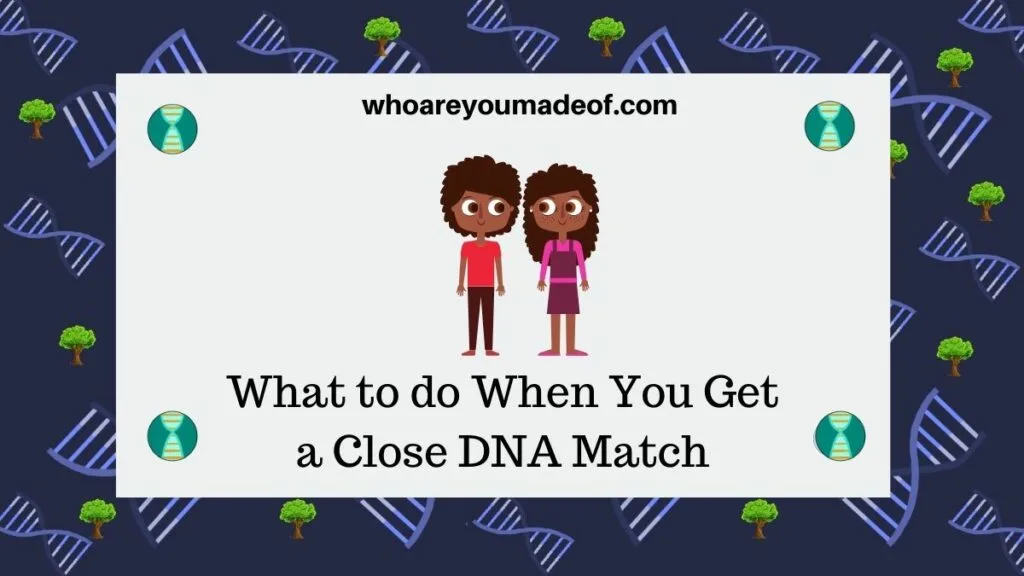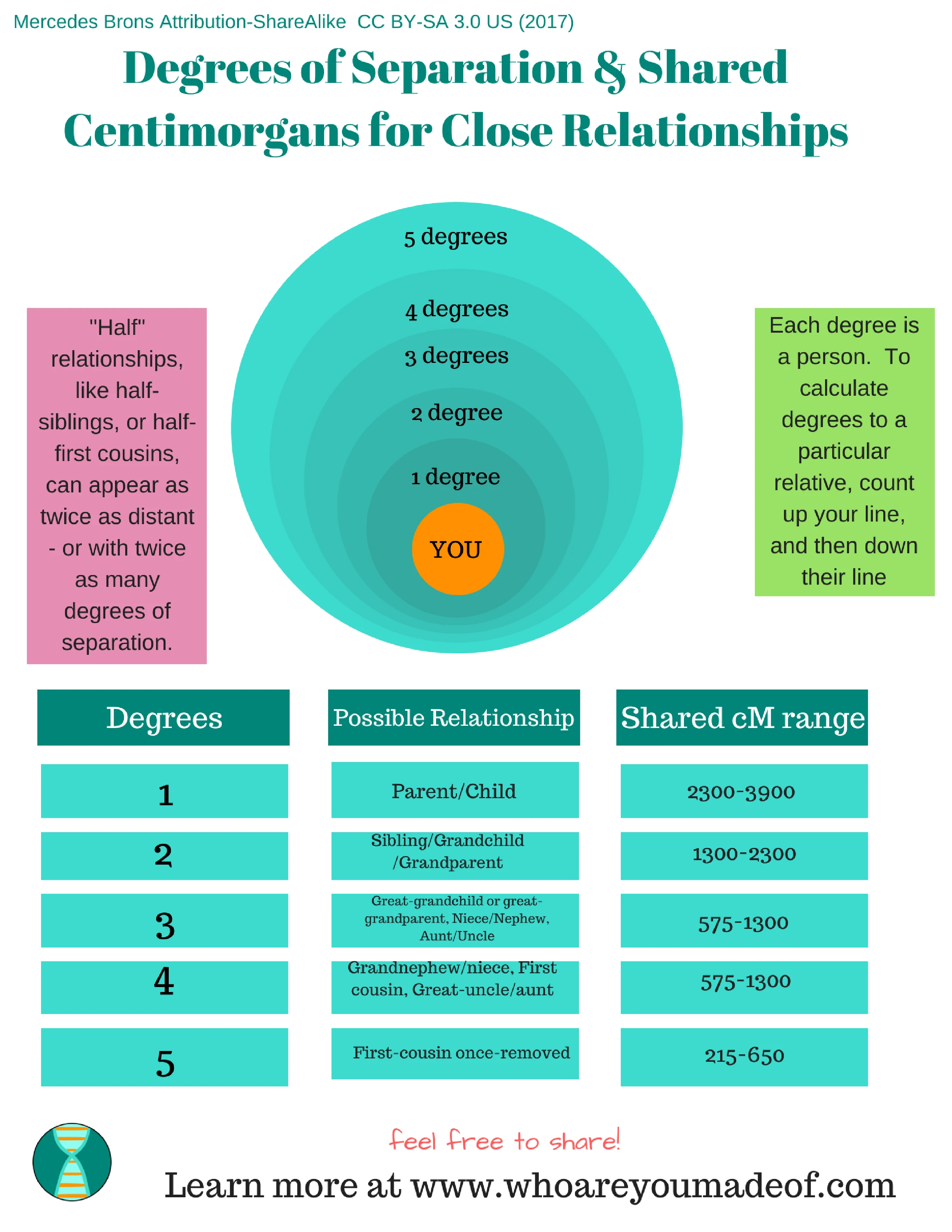If you find a new DNA match that appears to be closely related to you, you probably have a ton of questions. In this post, I'll give you some advice about what to do when you get a close DNA match, as well as give you a few strategies that might help you determine how you are related to your new match.
Depending on what you already know about your family's history, finding out that you have a new close DNA match can cause all sorts of emotions. It can be scary, confusing, exciting, exhilarating, angering, saddening, frustrating, pleasing, or even exhausting.

A single DNA match can turn what you thought you knew about your family upside-down, lead you to a biological parent, and lead to fulfilling relationships or disappointment.
In other words, a close DNA match is a big deal, and so the first steps that you take when you first spot the match are very important.
I define a close DNA match as someone who is estimated by your DNA testing company to be related to you as a first cousin or closer. Each testing company has different relationship categories, and generally speaking, the category that they place your match in is only an estimate.
The companies use the amount of shared DNA that you have as an estimate, since there are always a few different relationship possibilities for any given amount of shared DNA.
Take screenshots or notes from your match's profile and family tree
This may sound like strange advice, but I promise you that it isn't. When you first spot a new close DNA match, the first thing you should do is take screenshots of their profile and family tree, if they have one.
If you don't know how to take screenshots, then definitely consider just getting out a sheet of paper and writing down as much detail as you can find on the family tree. Make sure you write down their full name, their screen name, e-mail address, the names of their parents, grandparents, and great-grandparents.
Include as much detail as you possibly can - this information is for your own family research records.
Why do I recommend that you do this? Depending on your family's unique history, this new close DNA match may or may not be expecting to find other new close matches (i.e. you). When people are surprised or shocked by something, denial is a common reaction.
This sometimes leads people to delete their DNA results, and sometimes, even their accounts with various family research websites. You never know if and when a close match might decide that they aren't ready for "this whole DNA thing", and shut down access to their information.
Since you need as much information as possible about your match in order to determine your relationship, and possibly important information about your ancestry, it's important that you take notes/screenshots as soon as you can.
I only recommend that you write down information or take screenshots for your own information, and never to show to anyone else, or to use against someone in a dispute.
Additionally, I always recommend to respect the privacy of your DNA matches, which is why I stress that having a screenshot or two, or some notes on a match, is only to be used for your knowledge, and to help you figure out how you are related to your new match.
Take notes on your shared matches or common ancestors
If your new match has a family tree and you can see how you are related, make sure to take note of this (for the reasons that I mention above). More likely, your match doesn't yet have a family tree that they have posted, or they have a family tree that doesn't seem to match your family.
I recommend that you check to see which matches you share in common, and write them down. Shared matches are a good way to get an idea of which line of the family your match is on.
Shared matches are most reliable when they are shared relatively close matches. For example, a shared first cousin match, a shared half-sibling match, or a shared parent match will tell you a lot about how your match might be related.
The more distant the shared match, however, the higher chance that even though you both have a match in common, you are related in different ways to the shared match.
For example, if I have a first cousin match and I notice that we have a distant cousin in common, and I know that the distant cousin is on my mom's side, it doesn't necessarily mean that the first cousin is related on my mom's side.
It could be that the first cousin is on my dad's side, and the distant cousin match just happens to be related to both of us.
Check to see how much DNA you share with your new close DNA match
As I mentioned earlier, your DNA testing company uses the amount of shared DNA that you have with your match in order to estimate your relationship.
You can use this same information to come to your own conclusions, especially if you have additional information about your match that you gathered from their profile, family tree, and shared matches.
The amount of DNA that you share will fall within a range that might overlap with other relationship types, so you'll definitely have to use all of the information at your disposal.
Check your match for the number of shared centimorgans (cMs). This is the number that most people use in order to discuss the total amount of shared DNA.
The chart below can give you a good idea about what to expect for different close relationships. You can see that there is a big overlap, so any other information can really help eliminate relationship possibilities.

Consider contacting your match
Not everyone will want to reach out to a close DNA match, but if you think that you might want to, then this part is for you. I listed this section at the very end because I feel like all of the previous steps should be taken before any contact is made.
Of course, if they contact you first, it's totally okay! It's best to have as much information as possible so that way you know to whom you might be sending your message.
Individual circumstances might dictate that contacting a new DNA match be handled with delicacy, so sometimes it is best to send a friendly message, sharing a few surnames, letting them know that the website shows that you might be closely related, and asking whether they are interested in trying to determine the relationship.
You can read some of my posts about contacting matches here:
Conclusion
I hope that this post has helped you get some ideas about what to do with your new close DNA match. If you have any questions about something you read here, or you would like to share your own experience, I would love to hear from you in the comments.
Thanks for stopping by!


Bernadette
Sunday 15th of August 2021
I have a “match” to an individual who supposedly shares 1,743 cM. That would make her a grandparent or sibling, according to the chart. She’s too young to be my grandmother and it’s highly unlikely she’s a half-sibling because of my parents’ circumstances at the time.
My first cousin has never heard of her and neither have I. Furthermore, he said the same thing happened to his wife. She was also matched closely to an improbable person. He said it made his wife skeptical about the accuracy of Ancestry DNA tests. I feel the same way. It’s not just a case of denying that a half-sibling could exist. It just doesn’t make sense for a lot of reasons.
Over time, my results have shown I had Jewish DNA, then not; Italian/Greek DNA, then not; Central Asian, then not. I realize the science is evolving and the latest results mesh better with my tree. But the mystery “match” still perplexes me. I have tried to contact her, but to no avail.
Mercedes
Sunday 15th of August 2021
Bernadette, Thank you so much for your comment! I wish you the best of luck in determining how your mystery DNA match is related to you. Sincerely, Mercedes